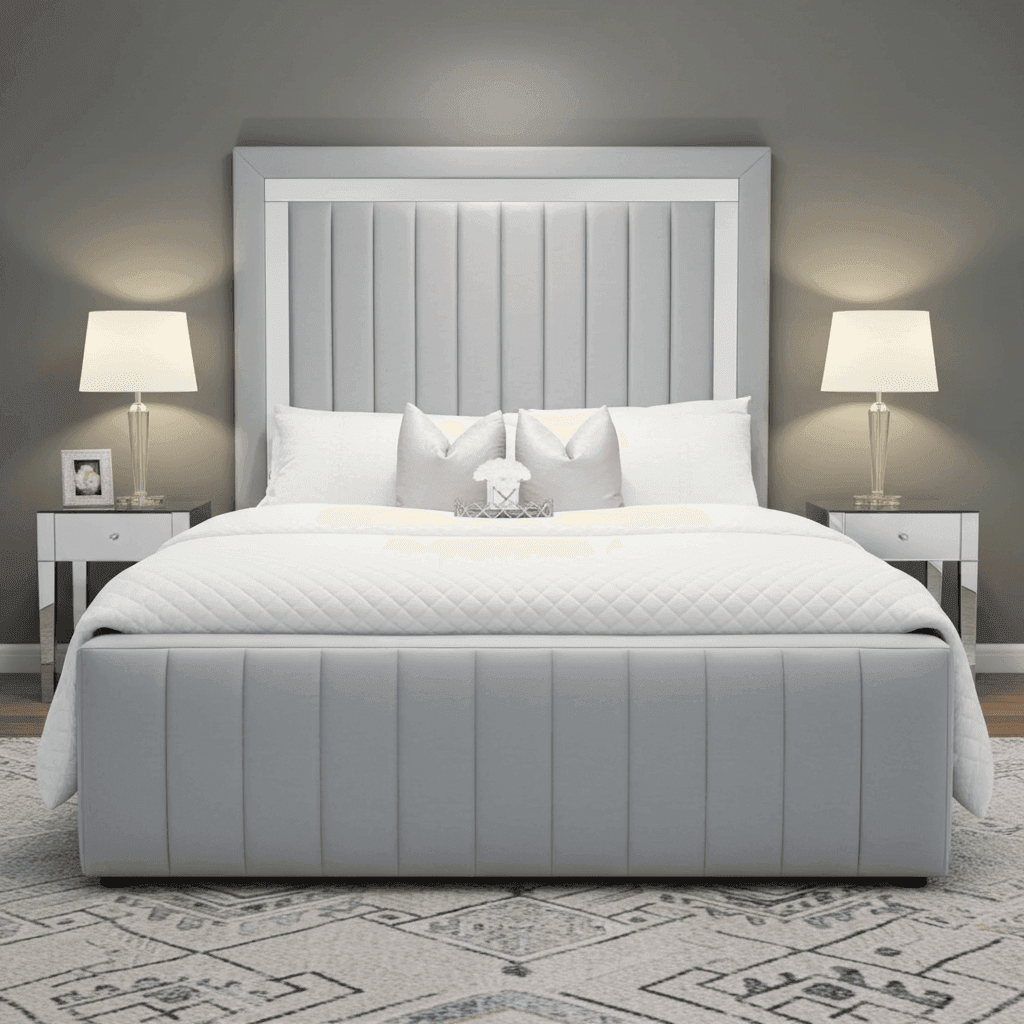A Guide to Coffee Machines for Your Daily Indulgence in UK
Discover the inner workings of coffee machines with our comprehensive guide. Learn about Drip Coffee Machines vs. Espresso Machines.
Exploring the World of Coffee Machines: Drip Coffee Machines vs. Espresso Machines
A coffee machine is an ingenious invention, an electric, automatic brewing system designed to craft the perfect cup of coffee. In today's modern world, we take these marvellous gadgets for granted. Still, their history is rich and intriguing, dating back to a time before electricity when non-electric methods were employed to brew this beloved beverage. Nowadays, coffee machines come in various brands and models, catering to household and commercial needs. These machines typically feature outer coverings made of metal or plastic, offering durability and aesthetic appeal.

Beds and Coffee Machines: The Perfect Match
In the pursuit of comfort and relaxation, there are few things that rival the combination of a luxurious bed and a high-quality coffee machine. Let's explore the synergy between luxury beds and pour-overs, including various bed styles such as sleigh beds, Ottoman beds, double beds, modern beds, and wall beds in the UK.
Luxury Bed: The Foundation of Comfort. A bed is the cornerstone of a restful night's sleep. It combines exquisite craftsmanship, premium materials, and thoughtful design to create a sleep sanctuary that beckons you after a long day. Here's a look at some bed styles that offer a touch of luxury:Sleigh Bed: Sleigh beds are renowned for their elegant and classic design. These beds feature a distinctive curved headboard and footboard, resembling the shape of a sleigh. Crafted from high-quality wood, they exude a sense of luxury and timelessness. Sleigh beds are perfect for those who appreciate a touch of traditional charm in their bedroom.
Ottoman Beds Double: especially in double sizes, Ottoman beds are celebrated for their versatility and storage solutions. These beds often come with hydraulic lifting mechanisms that allow you to raise the mattress and access the ample storage space underneath. Ottoman beds combine functionality with comfort, making them an excellent choice for those seeking style and practicality.
Modern Bed: Modern beds embrace clean lines, minimalistic design, and innovative materials. Their contemporary aesthetic characterizes them and can vary in styles from platform beds to low-profile frames. A modern bed complements a sleek and minimalist bedroom decor, providing a sense of tranquillity and sophistication.
Wall Bed (Murphy Bed) in the UK: Wall beds, also known as Murphy beds, are a space-saving marvel. These beds can be folded vertically against the wall when not in use, freeing up valuable floor space. In the UK, where space is premium, wall beds are popular for maximizing living areas. Sage PourIf you have a pour-over in your home, chances are it's a Sage pour-over.
Components of a Sage Coffee Machine
A Sage coffe machine comprises two main sections: the upper and lower compartments. If you disassemble your pour-over, you will discover its components are similar to those in most other machines.
In the upper section, you'll find:
- The Reservoir: This is the most significant component, serving as the receptacle for the water you pour into the machine, which is subsequently used to brew the coffee. Reservoirs can vary in size, with some capable of holding more water than others, but they all share a primary function – saving water.
- The Hot-Water Tube:
- An insulated tube runs from the bottom of the machine to the faucet at the top. This tube transfers the water from one location to another within the device.
- The Faucet: Functioning as a small showerhead, the faucet is positioned over the coffee grounds, spraying the water from the hot-water tube onto the feet. It ensures even saturation of the coffee grounds, guaranteeing the desired quality cup of coffee.
- The Sage Area: A small plastic component with holes, the Sage area separates the faucet from the coffee. It controls the rate at which the water descends onto the coffee grounds below.

In the lower section, you'll find:
- The Cold-Water Tube:
- This tube carries the cold water you pour into the pour-over, transporting it to be heated connecting the bottom of the reservoir to the line within the heating element.
- The Hot-Water Tube: This tube connects on one end to the line within the heating element and on the other end to the hot-water tube that extends through the machine to the faucet. Its purpose is to carry the water after it has been heated, ensuring it reaches the tap to be sprayed over the coffee grounds.
- The Heating Element:
- This component is crucial for heating the water, comprising a resistive heating element and a water-carrying tube made of aluminium. It connects the cold-water line to the hot-water tube, performing the essential heating process.
- The One-Way Valve: Located either in the reservoir's hole or in the heating element tube, the one-way valve ensures that water flows in the correct direction as it moves through your pour-over.
- The Power Cord Connection: The power cord is what you plug into the wall to supply the machine with electricity, energizing the entire process. Without it, your pour-over would be nothing more than a decorative piece.
How the Heating Element Functions?
The heating element within your pour-over plays a pivotal role, serving two crucial functions in the coffee-making process. Firstly, it heats the water before it is sprayed over the coffee grounds, and secondly, it keeps your coffee warm after it has been brewed.
The resistive heating element is a coiled wire that heats up when electricity is supplied. This element is typically embedded in plaster for durability between the metal warming plate beneath your coffee pot and the aluminium water tube.
The Coffee-Making Process with a Sage Pour- over
Brewing coffee with a Sage coffee maker is a relatively straightforward process from the user's perspective. All you need to do is fill the reservoir with water, measure the appropriate amount of coffee, place the coffee pot in position, and patiently wait. While you wait, your pour-over works diligently to prepare your morning brew. Let's take a closer look at the journey from water to coffee within your trusty machine:
- The reservoir begins in the reservoir, where you pour cold, filtered water. Once the pool is filled, you close it, allowing the machine to start its work.
- Cold-Water Tube: The water flows through the hole in the bottom of the reservoir into the cold-water tube located beneath.
- One-Way Valve: The cold-water tube guides the water through the one-way valve, ensuring it moves in the intended direction.
- Heating Element: The water enters the aluminium tube within the heating element. As the pour-over is turned on, the resistive heating element starts to heat up. After a few minutes, the water within the aluminium tube reaches boiling point.
- Boiling Water: The boiling water generates bubbles of an adequate size to push the hot water through the hot-water tube, which extends throughout the pour-over, ultimately reaching the faucet.
- Faucet: Positioned above the coffee grounds, the faucet sprays the hot water, ensuring it evenly sails over the coffee grounds.
- Saturation of Coffee Grounds: The hot water fully saturates the coffee grounds, extracting their flavours and carrying them into your waiting coffee pot.
Addressing Clogged Pour-overs
Occasionally, your pour-over may function differently than expected, typically due to clogging. Here are some straightforward steps you can take to unclog it and enjoy your daily cup of coffee:
- Clean the Pour-over: Add a cup of vinegar to the water-filled reservoir. Run your pour-over as usual until all the water has passed through the machine. Discard the rinse water. Follow this by running a pool full of clean water through your pour-over a couple of times to ensure all traces of vinegar are eliminated.
- Check the Drain Hole: Ensure that the hole at the bottom of the reservoir is not clogged. If it is, use a small wire or toothpick to clear the obstruction, allowing water to flow freely.
- Inspect the Water Spout: Ensure that the spout from which the coffee is dispensed is completely clean and not obstructed by any debris or residue.
- Clean the Valve: To access the valve, you may need to remove the base of the pour-over. Ensure that the machine is unplugged before proceeding. Clean the valve with warm water and detergent to remove any mineral deposits blocking it.
- Regular Maintenance: Regularly clean your coffee machine to prevent clogging and maintain the freshness and cleanliness of your coffee every morning.

Sage Coffee Machines vs. Espresso Machines
Now that we've explored the inner workings of coffee machines let's delve into the differences between drip coffee machines and espresso machines. The distinction lies primarily in the brewing method, which results in unique flavours, strengths, and brewing times.
- Roasting: Coffee beans used for drip coffee are typically roasted with the brewing method in mind. These beans tend to be lighter in roast, preserving the bean's natural acidity. In contrast, espresso beans are usually roasted much darker, imparting a more prosperous, bolder flavour required for espresso and espresso-based drinks like cappuccinos and lattes.
- Grinding: Espresso machines use finely ground coffee, resembling a powder, while coffee makers use a coarser, thicker grind.
- Brewing: Drip coffee machines require more time for brewing due to the coarser grind. The brewing process can take up to ten minutes. On the other hand, espresso machines brew and pour within about 30 seconds, thanks to the finer grind and higher pressure.
- Pressure: Espresso machines rely on high pressure to quickly force water through coffee grounds, usually in seconds. In contrast, coffee makers rely on gravity to gradually pull water through the coffee grounds and filter.
- Price: Coffee makers are generally more affordable than espresso machines due to their more straightforward functionality and fewer features. However, investing in a quality espresso machine is worth it if you seek barista-style coffee.
Espresso Machines vs. Coffee Makers: Which is Better?
Coffee enthusiasts often argue that espresso machines provide a more authentic, prosperous, and creamier coffee experience. Espresso machines also offer the flexibility to choose from various coffee types depending on your mood, taste, or desired strength. In comparison, coffee makers are single-function appliances that generally produce milder coffee. If you're a true coffee connoisseur, you will likely find the end product delivered by an espresso machine more to your liking.
Conclusion:
Coffee machines, whether humble drip coffee makers or sophisticated espresso machines are essential appliances in the lives of many individuals. They have come a long way since their inception, incorporating modern technology while adhering to the fundamental principles of coffee brewing. Coffee machines provide convenience and a milder coffee flavour, making them ideal for daily use. In contrast, espresso machines deliver an intense and rich coffee experience suited for those who appreciate the finer nuances of coffee. Regardless of your preference, a well-maintained coffee machine can consistently provide that comforting cup to kickstart your day. So, coffee machines continue to play a crucial role in satisfying our caffeine cravings, whether you're sipping a leisurely drip-brewed cup or savouring a shot of espresso.





0 comments